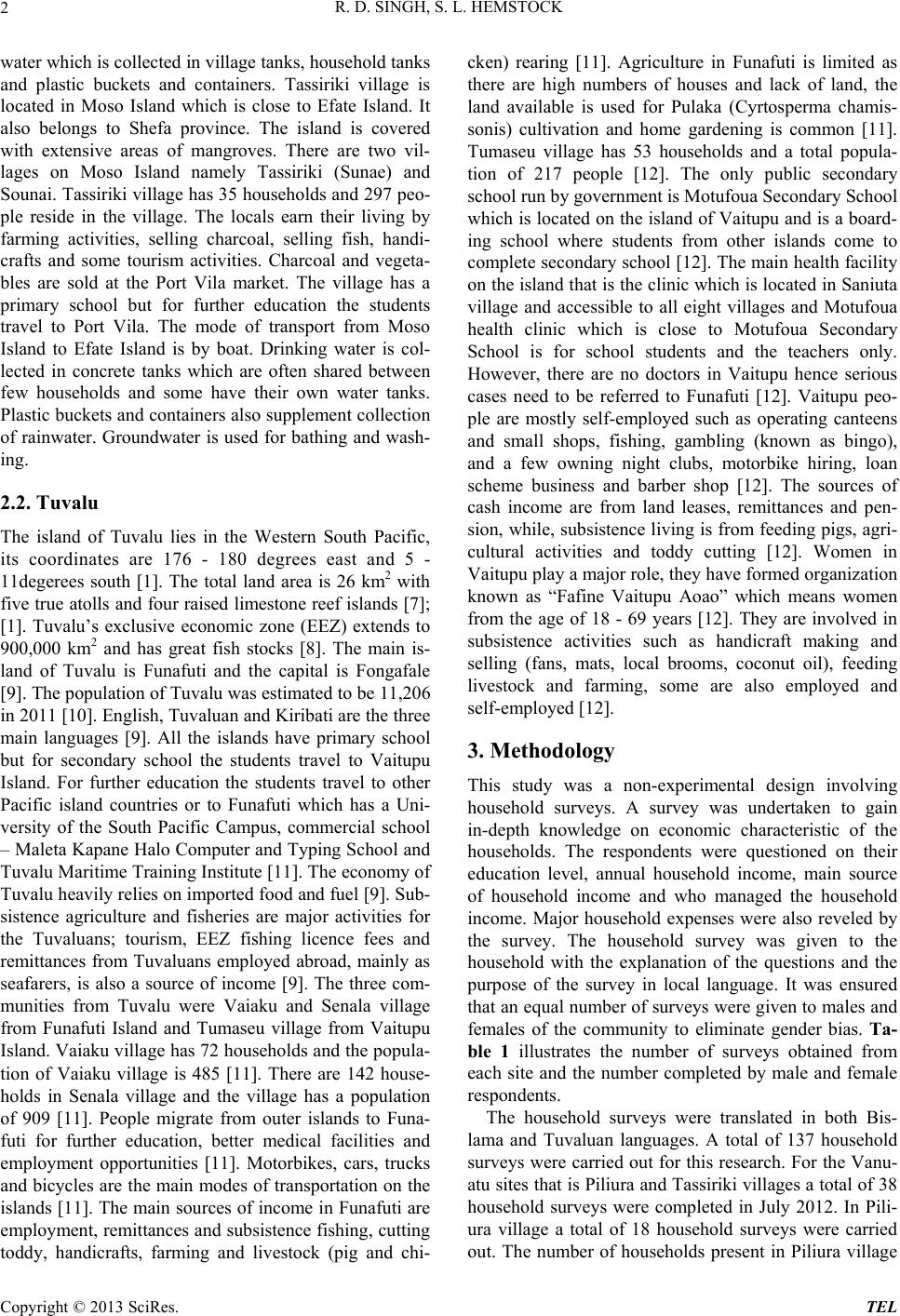
R. D. SINGH, S. L. HEMSTOCK
2
water which is collected in village tanks, household tanks
and plastic buckets and containers. Tassiriki village is
located in Moso Island which is close to Efate Island. It
also belongs to Shefa province. The island is covered
with extensive areas of mangroves. There are two vil-
lages on Moso Island namely Tassiriki (Sunae) and
Sounai. Tassiriki village has 35 househo lds and 297 peo-
ple reside in the village. The locals earn their living by
farming activities, selling charcoal, selling fish, handi-
crafts and some tourism activities. Charcoal and vegeta-
bles are sold at the Port Vila market. The village has a
primary school but for further education the students
travel to Port Vila. The mode of transport from Moso
Island to Efate Island is by boat. Drinking water is col-
lected in concrete tanks which are often shared between
few households and some have their own water tanks.
Plastic buckets and containers also supplement collection
of rainwater. Groundwater is used for bathing and wash-
ing.
2.2. Tuvalu
The island of Tuvalu lies in the Western South Pacific,
its coordinates are 176 - 180 degrees east and 5 -
11degerees south [1]. The total land area is 26 km2 with
five true atolls and four raised limestone reef islands [7];
[1]. Tuvalu’s exclusive economic zone (EEZ) extends to
900,000 km2 and has great fish stocks [8]. The main is-
land of Tuvalu is Funafuti and the capital is Fongafale
[9]. The population of Tuvalu was estimated to be 11,206
in 2011 [10]. English, Tuvaluan and Kiribati are the three
main languages [9]. All the islands have primary school
but for secondary school the students travel to Vaitupu
Island. For further education the students travel to other
Pacific island countries or to Funafuti which has a Uni-
versity of the South Pacific Campus, commercial school
– Maleta Kapane Halo Computer and Typing School and
Tuvalu Maritime Training Institute [11 ]. The economy of
Tuvalu heavily relies on imported food and fuel [9]. Sub-
sistence agriculture and fisheries are major activities for
the Tuvaluans; tourism, EEZ fishing licence fees and
remittances from Tuvaluans employed abroad, mainly as
seafarers, is also a source of income [9]. The three com-
munities from Tuvalu were Vaiaku and Senala village
from Funafuti Island and Tumaseu village from Vaitupu
Island. Vaiaku village has 72 households and th e popula-
tion of Vaiaku village is 485 [11]. There are 142 house-
holds in Senala village and the village has a population
of 909 [11]. People migrate from outer islands to Funa-
futi for further education, better medical facilities and
employment opportunities [11]. Motorbikes, cars, trucks
and bicycles are the main modes of transportation on the
islands [11]. The main sources of in come in Funafuti are
employment, remittances and subs istence fishing, cutting
toddy, handicrafts, farming and livestock (pig and chi-
cken) rearing [11]. Agriculture in Funafuti is limited as
there are high numbers of houses and lack of land, the
land available is used for Pulaka (Cyrtosperma chamis-
sonis) cultivation and home gardening is common [11].
Tumaseu village has 53 households and a total popula-
tion of 217 people [12]. The only public secondary
school run by government is Motufoua Secondary School
which is located on the island of Vaitupu and is a board-
ing school where students from other islands come to
complete secondary school [12]. The main health facility
on the island that is the clin ic which is located in Saniu ta
village and accessible to all eight villages and Motufoua
health clinic which is close to Motufoua Secondary
School is for school students and the teachers only.
However, there are no doctors in Vaitupu hence serious
cases need to be referred to Funafuti [12]. Vaitupu peo-
ple are mostly self-employed such as operating canteens
and small shops, fishing, gambling (known as bingo),
and a few owning night clubs, motorbike hiring, loan
scheme business and barber shop [12]. The sources of
cash income are from land leases, remittances and pen-
sion, while, subsistence living is from feeding pigs, agri-
cultural activities and toddy cutting [12]. Women in
Vaitupu play a major role, they have formed organization
known as “Fafine Vaitupu Aoao” which means women
from the age of 18 - 69 years [12]. They are involved in
subsistence activities such as handicraft making and
selling (fans, mats, local brooms, coconut oil), feeding
livestock and farming, some are also employed and
self-employed [12] .
3. Methodology
This study was a non-experimental design involving
household surveys. A survey was undertaken to gain
in-depth knowledge on economic characteristic of the
households. The respondents were questioned on their
education level, annual household income, main source
of household income and who managed the household
income. Major household expenses were also reveled by
the survey. The household survey was given to the
household with the explanation of the questions and the
purpose of the survey in local language. It was ensured
that an equal number of surveys were given to males and
females of the community to eliminate gender bias. Ta-
ble 1 illustrates the number of surveys obtained from
each site and the number completed by male and female
respondents.
The household surveys were translated in both Bis-
lama and Tuvaluan languages. A total of 137 household
surveys were carried out for this research. For the Vanu-
atu sites that is Piliura and Tassirik i villages a total of 38
household surveys were completed in July 2012. In Pili-
ura village a total of 18 household surveys were carried
out. The number of households present in Piliura village
Copyright © 2013 SciRes. TEL